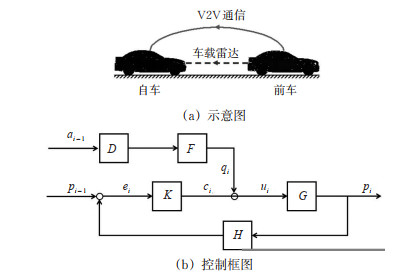A Performance Analysis of Mixed Platoon Control under Communication Delay
-
摘要: 针对CACC协同自适应巡航控制技术,探究其在车联网通信时延影响下,与驾驶员驾驶汽车共存而构成的混合队列系统的性能。从微观跟车行为角度,基于频域传递函数,推导通信时延下的CACC队列稳定最小跟车时距的理论表达式,并通过数值验证指出CACC队列稳定最小跟车时距随通信时延增大而增大的特性。从交通激波特性角度,针对无时延CACC、有时延CACC和时延过大而退化后的ACC自适应巡航3种情形,给定相同的跟车时距,进行不同渗透率下的大规模交通仿真实验,实验结果表明,在无时延和1 s时延这2种情形下,CACC在20%及以上的渗透率时均能显著降低交通扰动,削弱激波,性能差别不明显; 相比而言,退化后的ACC性能明显恶化。Abstract: Based on technologies of automatic control and wireless communication, e.g., vehicle-to-vehicle(V2V)communication, intelligent and connected vehicles(ICVs)are believed to improve traffic performance significantly. This paper investigates the performance of mixed platoon systems consisting of ICVs, adopting cooperative adaptive cruise control(CACC), and human-driven vehicles(HDVs)under the influences of communication delay in vehicular networks. From microscopic car-following behaviors, the minimum time headway for string stability is obtained based on the frequency-domain transfer function and increases as time delay grows up, verified by numerical calculation. Large-scale traffic simulations under multiple penetration rates are conducted from traffic shockwaves, with three cases under consideration, including CACC without delay, CACC with delay, and adaptive cruise control(ACC), which degrades from CACC at an extensively considerable delay. Given the same headway for the three cases, extensive simulation results show that CACC without delay or with a communication delay of 1 s can reduce traffic perturbations and dampen traffic shockwaves, with no evident performance gaps. By contrast, ACC achieves a much worse performance compared to CACC.
-
表 1 反馈控制K(s) 的参数取值
Table 1. Parameter setup for the feedback K(s)
第1组 第2组 kp 0.40 0.90 kd 1.20 2.70 表 2 头车运动轨迹
Table 2. Velocity profile of the leading vehicle
时间/s 轨迹 0≤ t < 30 头车以25 m/s的速度匀速行驶,跟随车辆达到稳定 30≤ t < 33 头车以-5 m/s2的加速度进行紧急制动 33≤ t < 38 头车保持10 m/s的速度匀速行驶 38 ≤t < 53 头车以1 m/s2加速度恢复至25 m/s的速度 53≤ t≤ 200 头车以25 m/s匀速行驶 表 3 交通仿真中的参数取值
Table 3. Parameter setup in traffic simulation
参数 符号 数值 驾驶员反应延迟/s τ 0.5 自由加速度指数 δ 4.0 车辆最大加速度/(m/s2) am 2.0 车辆最大减速度/(m/s2) bm 5.0 驾驶员舒适加速度/(m/s2) ac 1.4 驾驶员舒适减速度/(m/s2) bc 2.0 驾驶员期望速度/(m/s2) vd 25.0 静止时的车距/m s0 0.0 车辆动力学参数 η 0.1 期望时距/s hd 1.2 期望速度/(m/s) vd 25.0 控制器P参数 kp 0.9 控制器D参数 kd 2.7 -
[1] TREIBER M, KESTING A. Traffic flow dynamics: data, models and simulation[M]. Berlin: Springer, 2013. [2] SUGIYAMA Y, FUKUI M, KIKUCHI M, et al. Traffic jams without bottlenecks-experimental evidence for the physical mechanism of the formation of a jam[J]. New Journal of Physics, 2008, 10(3): 033001. doi: 10.1088/1367-2630/10/3/033001 [3] 李克强, 戴一凡, 李升波, 等. 智能网联汽车(ICV)技术的发展现状及趋势[J]. 汽车安全与节能学报, 2017, 8(1): 1-14. doi: 10.3969/j.issn.1674-8484.2017.01.001LI Keqiang, DAI Yifan, LI Shengbo, et al. State-of-the-art and technical trends of intelligent and connected vehicles[J]. Journal of Automotive Safety and Energy, 2017, 8(1): 1-14. (in Chinese) doi: 10.3969/j.issn.1674-8484.2017.01.001 [4] LI S E, ZHENG Y, LI K, et al. Dynamical modeling and distributed control of connected and automated vehicles: challenges and opportunities[J]. IEEE Intelligent Transportation Systems Magazine, 2017, 9(3): 46-58. doi: 10.1109/MITS.2017.2709781 [5] STERN R E, CUI S, Delle Monache M L, et al. Dissipation of stop-and-go waves via control of autonomous vehicles: Field experiments[J]. Transportation Research Part C: Emerging Technologies, 2018, 89: 205-221. doi: 10.1016/j.trc.2018.02.005 [6] TALEBPOUR A, MAHMASSANI H S. Influence of connected and autonomous vehicles on traffic flow stability and throughput[J]. Transportation Research Part C: Emerging Technologies, 2016(71): 143-163. http://smartsearch.nstl.gov.cn/paper_detail.html?id=8f54faf4ca968a5b80ae02ed02373f6d [7] SCHAKEL W J, VAN AREM B, NETTEN B D. Effects of cooperative adaptive cruise control on traffic flow stability[C]. 13th International IEEE Conference on Intelligent Transportation Systems, Funchal, Portugal: IEEE, 2010. [8] GUÚRIAU M, BILLOT R, El FAOUZI N E, et al. How to assess the benefits of connected vehicles? A simulation framework for the design of cooperative traffic management strategies[J]. Transportation Research Part C: Emerging Technologies, 2016 (67): 266-279. http://smartsearch.nstl.gov.cn/paper_detail.html?id=4fb55e68eb689b922c495d007bc1e371 [9] 秦严严, 王昊, 王炜, 等. 不同CACC渗透率条件下的混合交通流稳定性分析[J]. 交通运输系统工程与信息, 2017, 17(4): 63-69+104.QIN Yanyan, WANG Hao, WANG Wei, et al. Mixed traffic flow string stability analysis for different cacc penetration ranges[J]. Journal of Transportation Systems Engineering and Information Technology, 2017, 17(4): 63-69 + 104. (in Chinese) [10] SHLADOVER S, SU D, LU X Y. Impacts of cooperative adaptive cruise control on freeway traffic flow[J]. Transportation Research Record: Journal of the Transportation Research Board, 2012(2324): 63-70. http://www.researchgate.net/publication/266391703_Impacts_of_Cooperative_Adaptive_Cruise_Control_on_Freeway_Traffic_Flow_Impacts_of_Cooperative_Adaptive_Cruise_Control_on_Freeway_Traffic_Flow [11] ZHENG Y, WANG J, LI K. Smoothing traffic flow via control of autonomous vehicles[J]. IEEE Internet of Things Journal, 2020, 7(5): 3882-3896. doi: 10.1109/JIOT.2020.2966506 [12] WANG J, ZHENG Y, XU Q, et al. Controllability analysis and optimal control of mixed traffic flow with human-driven and autonomous vehicles[J/OL]. (2020-06-29)[2021-01-01]. https://ieeexplore.ieee.org/abstract/document/9127876. [13] DEY K C, YAN L, WANG X, et al. A review of communication, driver characteristics, and controls aspects of cooperative adaptive cruise control(CACC)[J]. IEEE Transactions on Intelligent Transportation Systems, 2015, 17(2): 491-509. http://ieeexplore.ieee.org/document/7314936/references [14] 郑洋. 基于四元素构架的车辆队列动力学建模与分布式控制[D]. 北京: 清华大学, 2015.ZHENG Yang. Dynamic modeling and distributed control of vehicular platoon under the four-component framework[D]. Beijing: Tsinghua University, 2015. (in Chinese) [15] PLOEG J, SCHEEPERS B T M, VAN NUNEN E, et al. Design and experimental evaluation of cooperative adaptive cruise control[C]. 14th International IEEE Conference on Intelligent Transportation Systems, Washington, DC, USA: IEEE, 2011. [16] NAUS G J L, VUGTS R P A, PLOEG J, et al. String-stable CACC design and experimental validation: A frequency-domain approach[J]. IEEE Transactions on Vehicular Technology, 2010, 59(9): 4268-4279. doi: 10.1109/TVT.2010.2076320 [17] ÖNCÜ S, PLOEG J, VAN DE WOUW N, et al. Cooperative adaptive cruise control: Network-aware analysis of string stability[J]. IEEE Transactions on Intelligent Transportation Systems, 2014, 15(4): 1527-1537. doi: 10.1109/TITS.2014.2302816 [18] KESTING A, TREIBER M, HELBING D. Enhanced intelligent driver model to access the impact of driving strategies on traffic capacity[J]. Philosophical Transactions of the Royal Society of London A: Mathematical, Physical and Engineering Sciences, 2010, 368(1928): 4585-4605. doi: 10.1098/rsta.2010.0084 -





 下载:
下载:










